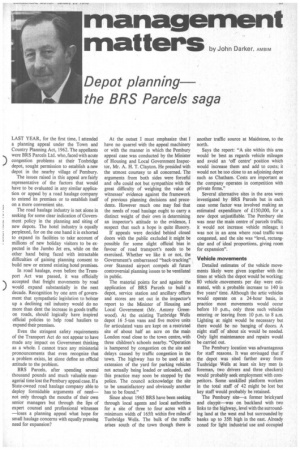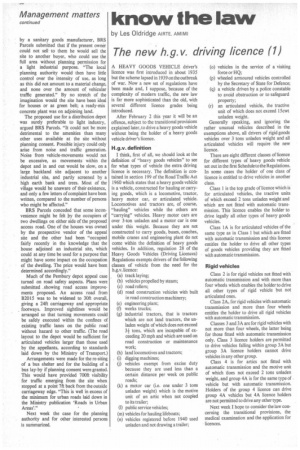management
Page 57

Page 58

If you've noticed an error in this article please click here to report it so we can fix it.
matters by John Darker, AM BIM
Depot planning the BRS Parcels saga
LAST YEAR, for the first time, I attended a planning appeal under the Town and Country Planning Act, 1962. The appellants were BRS Parcels Ltd. who, faced with acute congestion problems at their Ton bridge depot, sought permission to establish a new depot in the nearby village of Pembury.
The issues raised in this appeal are fairly representative of the factors that would have to be evaluated in any similar application or appeal by a road haulage company to extend its premises or to establish itself on a more convenient site.
The road haulage industry is not alone in seeking for some clear indication of Government policy in the planning and siting of new depots. The hotel industry is equally perplexed, for on the one hand it is exhorted to expand its facilities to take account of millions of new holiday visitors to be expected in the Jumbo Jet era, while on the other hand being faced with intractable difficulties of gaining planning consent to build new or extend existing hotel premises.
In road haulage, even before the Transport Act was passed, it was officially accepted that freight movements by road would expand substantially in the next decade. Recognition by one arm of government that sympathetic legislation to bolster up a declining rail industry would do no more than dent the increase in goods traffic on roads, should logically have inspired official policies to help road hauliers to expand their premises.
Even the stringent safety requirements of the Transport Act do not appear to have made any impact on Government thinking as a whole. I cannot trace any ministerial pronouncements that even recognize that a problem exists, let alone define an official attitude to the problem.
BRS Parcels, after spending several thousand pounds and much valuable managerial time lost the Pembury appeal case. If a State-owned road haulage company able to deploy formidable arguments of need— not only through the mouths of their own senior managers but through the lips of expert counsel and professional witnesses —loses a planning appeal what hope for small haulage concerns with equally pressing need for expansion? At the outset I must emphasize that I have no quarrel with the appeal machinery or with the manner in which the Pembury appeal case was conducted by the Minister of Housing and Local Government Inspector, Mr. A. H. T. Clayton. He presided with the utmost courtesy to all concerned. The arguments from both sides were forceful and ae could not but sympathize with the great difficulty of weighing the value of witnesses' evidence against the framework of previous planning decisions and precedents. However much one may feel that the needs of road haulage ought to carry a distinct weight of their own in determining an inspector's attitude to the evidence, I suspect that such a hope is quite illusory.
If appeals were decided behind closed doors with the public excluded it might be possible for some slight official bias in favour of road transport's needs to be exercised. Whether we like it or not, the Government's embarrassed "back-tracking" over Stansted airport compels all future controversial planning issues to be ventilated in public.
The material points for and against the application of BRS Parcels to build a depot, service station and ancillary offices and stores are set out in the inspector's report to the Minister of Housing and Local Government (Mr. Antony Greenwood). At the existing Tunbridge Wells depot 16 5-ton vans and five motive units for articulated vans are kept on a restricted site of about half an acre on the main London road close to the town centre, with three children's schools nearby. "Operation is hampered by congestion on the site and delays caused by traffic congestion in the town. The highway has to be used as an extension of the yard for parking vehicles not actually being loaded or unloaded, and this practice may soon be stopped by the police. The council acknowledge the site to be unsatisfactory and obviously another has to be found."
Since about 1965 BRS have been seeking through local agents and local authorities for a site of three to four acres with a minimum width of 165ft within five miles of Tunbridge Wells. The bulk of the traffic arises south of the town though there is another traffic source at Maidstone, to the north.
Says the report: "A site within this area would be best as regards vehicle mileages and avoid an 'off centre' position which would increase them and add to costs; it would not be too close to an adjoining depot such as Chatham. Costs are important as the company operates in competition with private firms.
Several alternative sites in the area were investigated by BRS Parcels but in each case some factor was involved making an estimated expenditure of £150,000, for a new depot unjustifiable. The Pembury site was near the main centre of parcels traffic; it would not increase vehicle mileage; it was not in an area where road traffic was congested, and the site was "level, rectangular and of ideal proportions, giving room for expansion".
Vehicle movements Detailed estimates of the vehicle movements likely were given together with the times at which the depot would be working: 80 vehicle .movements per day were estimated with a probable increase to 140 in five years' time. Although the artic vehicles would operate on a 24-hour basis, in practice most movements would occur before 10 p.m., only three such vehicles entering or leaving from 10 p.m. to 8 a.m. Lighting at night would be necessary but there would be no banging of doors. A night staff of about six would be needed. Only light maintenance and repairs would be carried out.
The Pembury location was advantageous for staff reasons. It was envisaged that if the depot was sited farther away from Tunbridge Wells at least six key men (a foreman, two drivers and three checkers) would probably seek employment with competitors. Some unskilled platform workers in the total staff of 42 might be lost but key staff would probably be retained.
The Pembury site—a former brickyard and claypit—was on backland with two links to the highway, level with the surrounding land at the west end but surrounded by banks up to 35ft high in the east. Already zoned for light industrial use and occupied by a sanitary goods manufacturer, BRS Parcels submitted that if the present owner could not sell to them he would sell the site to another buyer, who could use the full area without planning permission for a light industrial purpose. "The local planning authority would then have little control over the intensity of use, as long as this did not amount to a material change, and none over the amount of vehicular traffic generated." By no stretch of the imagination would the site have been ideal for houses or as green belt; a ready-mix concrete plant was on adjoining land.
The proposed use for a distribution depot was surely preferable to light industry, argued BRS Parcels. "It could not be more detrimental to the amenities than many other uses available at the site without planning consent. Possible injury could only arise from noise and traffic generation. Noise from vehicle-movements would not be excessive, as movements within the depot and in and out would be slow, on a large backland site adjacent to another industrial site, and partly screened by a high earth bank and trees. Most of the village would be unaware of their existence, and only a few letters of complaint have been written, compared to the number of persons who might be affected."
BRS Parcels conceded that some inconvenience might be felt by the occupiers of two dwellings on either side of the proposed access road. One of the houses was owned by the prospective vendor of the appeal site and the other had been "occupied fairly recently in the knowledge that the house adjoined an industrial site, which could at any time be used for a purpose that might have some impact on the occupation of the dwelling. The price would have been determined accordingly."
Much of the Pembury depot appeal case turned on road safety aspects. Plans were submitted . showing road access improvements proposed. An access road from B2015 was to be widened to 30ft overall, giving a 24ft carriageway and appropriate footways. Improved sightlines would be arranged so that turning movements could be safely executed within the confines of existing traffic lanes on the public road without hazard to other traffic. (The road layout to the depot would be sufficient for articulated vehicles larger than those used by the appellants, according to standards laid down by the Ministry of Transport.) Arrangements were made for the re-siting of a bus shelter and for the building of a bus lay-by if planning consent were granted. This would have provided 700ft visibility for traffic emerging from the site when stopped at a point 7ft back from the outside carriageway edge. "This is well in excess of the minimum for urban roads laid down in the Ministry publication 'Roads in Urban Areas'."
Next week the case for the planning authority and for other interested persons is summarized.








































































































